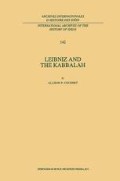Abstract
One of the first to suggest that Leibniz was influenced by van Helmont was Heinrich Ritter in 1853. Ritter argued that of all Leibniz’s contemporaries, van Helmont was closest to him both personally and in terms of his thought.109 R. W. Meyer also recognized “many intellectual affinities between the two men.” He believed Leibniz had appropriated the term “monad” from van Helmont, but he did not think that was enough to bridge the vast difference between the philosophies of the two men. Van Helmont remains in his view an eccentric mystic and enthusiast, whose ideas form an incoherent jumble, while Leibniz is the systematic, rational, and logical thinker, who subordinates his mystical inclinations to scientific ends. Hence, van Helmont’s role was to inspire in Leibniz ideas which he himself could not comprehend. Furthermore, van Helmont was only one of many contemporaries to influence Leibniz; his influence was therefore in no way special:
With Frans Mercurius van Helmont ... Leibniz had many actual interests in common, and in spite of a great difference in age there are many intellectual affinities between the two men; and thus Helmont’s life and his way of thinking deserve somewhat closer attention. For in discussing Helmont’s thought we hope to bring out once again Leibnitz’s many affinities with the contemporary ways of thought, and to show that the only thing which distinguishes him from other contemporary thinkers is his highly conscious and urgent sense of commitment to the problems of his age. ... [Van Helmont’s] adventurous life is reflected in his writings: a vast collection of inventions, plans, prescriptions, formulae and curious calculations on past and future events; violent attacks on Descartes, Spinoza and Hobbes; sketches for a mechanistic cosmology; empiricist and sensualist theories; and cabalistic and mystical theories of number — all these lie jumbled up in his countless papers. Yet everything he wrote was inspired by his enthusiastic plans for the Academies in which he hoped to see his projects executed; and all his projects were conceived with a view to their imme?diate practical application. His “natural” Hebrew alphabet, for instance, was to be used for curing the deaf and dumb; he devised a mechanical method for curing scoliosis — claiming that an English woman had opened a hospital in London in which the method was used with great success; he had cures for every kind of ailment, affliction and debility. Yet the ultimate purpose of all his speculations was once again a reunion of the Churches; already he saw secret signs of the future Universal Church that would be proclaimed in the new century. Leibnitz, though more cautious and sober in his hopes, shared Helmont’s belief that this future Church could only be of permanent benefit to the peoples of Europe if it were armed with all the ideas of the new science. In this belief Leibnitz founded in 1700 the Berlin Academy. In Helmont’s mind (as in Leibnitz’s) this scientific chiliasm was inextricably linked with philosophical doctrine. The aim was to reconcile theology with the “philosophia reformata”.
Access this chapter
Tax calculation will be finalised at checkout
Purchases are for personal use only
Preview
Unable to display preview. Download preview PDF.
Author information
Authors and Affiliations
Rights and permissions
Copyright information
© 1995 Springer Science+Business Media Dordrecht
About this chapter
Cite this chapter
Coudert, A.P. (1995). Van Helmont, Leibniz, and the Kabbalah. In: Leibniz and the Kabbalah. International Archives of the History of Ideas / Archives Internationales d’Histoire des Idées, vol 142. Springer, Dordrecht. https://doi.org/10.1007/978-94-017-2069-4_3
Download citation
DOI: https://doi.org/10.1007/978-94-017-2069-4_3
Publisher Name: Springer, Dordrecht
Print ISBN: 978-90-481-4465-5
Online ISBN: 978-94-017-2069-4
eBook Packages: Springer Book Archive

